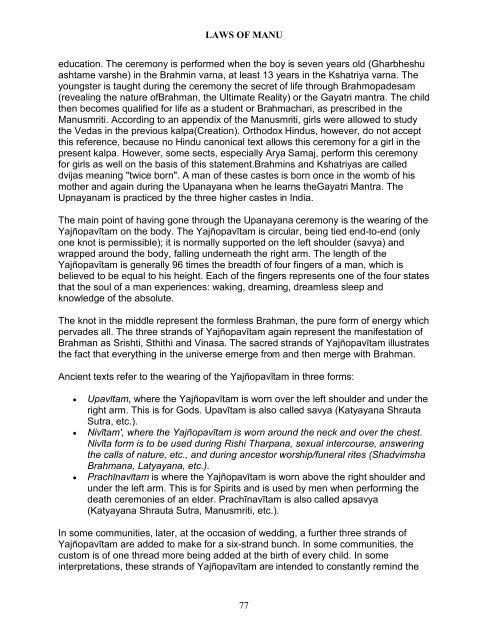Create successful ePaper yourself
Turn your PDF publications into a flip-book with our unique Google optimized e-Paper software.
LAWS OF MANU<br />
education. The ceremony is performed when the boy is seven years old (Gharbheshu<br />
ashtame varshe) in the Brahmin varna, at least 13 years in the Kshatriya varna. The<br />
youngster is taught during the ceremony the secret of life through Brahmopadesam<br />
(revealing the nature ofBrahman, the Ultimate Reality) or the Gayatri mantra. The child<br />
then becomes qualified for life as a student or Brahmachari, as prescribed in the<br />
Manusmriti. According to an appendix of the Manusmriti, girls were allowed to study<br />
the Vedas in the previous kalpa(Creation). Orthodox Hindus, however, do not accept<br />
this reference, because no Hindu canonical text allows this ceremony for a girl in the<br />
present kalpa. However, some sects, especially Arya Samaj, perform this ceremony<br />
for girls as well on the basis of this statement.Brahmins and Kshatriyas are called<br />
dvijas meaning "twice born". A man of these castes is born once in the womb of his<br />
mother and again during the Upanayana when he learns theGayatri Mantra. The<br />
Upnayanam is practiced by the three higher castes in India.<br />
The main point of having gone through the Upanayana ceremony is the wearing of the<br />
Yajñopavītam on the body. The Yajñopavītam is circular, being tied end-to-end (only<br />
one knot is permissible); it is normally supported on the left shoulder (savya) and<br />
wrapped around the body, falling underneath the right arm. The length of the<br />
Yajñopavītam is generally 96 times the breadth of four fingers of a man, which is<br />
believed to be equal to his height. Each of the fingers represents one of the four states<br />
that the soul of a man experiences: waking, dreaming, dreamless sleep and<br />
knowledge of the absolute.<br />
The knot in the middle represent the formless Brahman, the pure form of energy which<br />
pervades all. The three strands of Yajñopavītam again represent the manifestation of<br />
Brahman as Srishti, Sthithi and Vinasa. The sacred strands of Yajñopavītam illustrates<br />
the fact that everything in the universe emerge from and then merge with Brahman.<br />
Ancient texts refer to the wearing of the Yajñopavītam in three forms:<br />
• Upavītam, where the Yajñopavītam is worn over the left shoulder and under the<br />
right arm. This is for Gods. Upavītam is also called savya (Katyayana Shrauta<br />
Sutra, etc.).<br />
• Nivītam', where the Yajñopavītam is worn around the neck and over the chest.<br />
Nivīta form is to be used during Rishi Tharpana, sexual intercourse, answering<br />
the calls of nature, etc., and during ancestor worship/funeral rites (Shadvimsha<br />
Brahmana, Latyayana, etc.).<br />
• Prachīnavītam is where the Yajñopavītam is worn above the right shoulder and<br />
under the left arm. This is for Spirits and is used by men when performing the<br />
death ceremonies of an elder. Prachīnavītam is also called apsavya<br />
(Katyayana Shrauta Sutra, Manusmriti, etc.).<br />
In some communities, later, at the occasion of wedding, a further three strands of<br />
Yajñopavītam are added to make for a six-strand bunch. In some communities, the<br />
custom is of one thread more being added at the birth of every child. In some<br />
interpretations, these strands of Yajñopavītam are intended to constantly remind the<br />
77


















